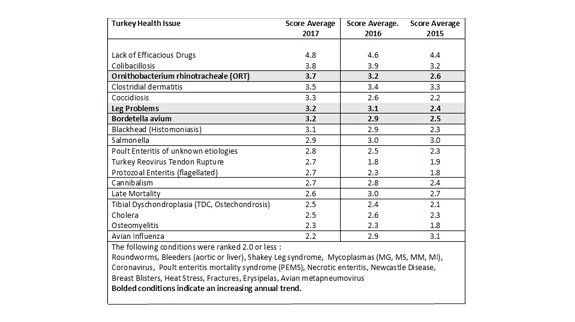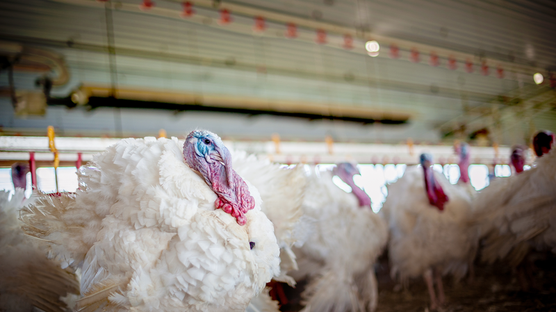Published on March 29, 2018
An update on turkey health trends
Which health issues pose the biggest risk to the US turkey industry? A group of professionals and veterinarians were recently asked this question, with some interesting trends shown.
The following article is a summary of a presentation discussed at the Turkey Science and Production Conference held in Chester, UK on March 21-23. Download the full white paper for more details.
The subcommittee of the United States Animal Health Association, led by the chair, Dr. Steven Clark, regularly surveys health professionals and veterinarians regarding the health status of turkeys. These results from August 2015 to August 2017 are summarized in Table 1, ranking diseases by economic impact. This article will discuss three diseases showing a significant increase over the past three years: Ornithobacterium rhinotracheale (ORT), Bordetella avium (BA), and Leg problems.
Table 1. Turkey health survey (August 2015 – Aug 2017) of professionals in USA turkey production ranking current disease issues

ORT (Ornithobacterium rhinotracheale)
In 1995, ORT became a major cause of respiratory disease and mortality in both commercial and breeder turkeys in the Midwest USA. Since that time ORT became endemic across most of the USA with breeder companies responding with the use of autogenous vaccines. Recently, ORT has moved from # 7 in ranking in 2015 to #3 in 2017. Why has the rating for ORT increased? There are several possible factors:
- the emergence of new ORT strains to which birds have no immunity
- the change to a ‘brood and move’ system, also known as single age operations. This system was designed to isolate younger birds from older birds in an effort to control PEMS, which devastated the turkey industry at one time. This system, however, prevents natural exposure to the disease and thus the development of immunity prior to flocks entering the finishing barns. In 2009, 39% of operations were single age, compared to 63% in 2017.
- ineffective or inconsistent water sanitation
- the presence of wild birds in barns
Due to the lack of commercially available live vaccines, controlled exposure of younger birds in the brooding barn has shown promising results in the field. Some commercial farmers have moved litter from barns with older birds to barns with younger birds to try and expose them naturally. Although this may work to provide exposure to ORT, it is important to be aware that it may result in younger birds being exposed to other pathogens such a reovirus or salmonella.
Bordetella avium (BA)
The economic impact of this immunosuppressive and damaging bacteria, continues to increase each year. It is well documented that poults exposed to BA do not respond adequately to vaccines such as Newcastle or Hemorrhagic Enteritis which leaves them susceptible to these agents later in life. The primary focus to eliminate this disease agent centers on water system cleaning and disinfection and continuous water sanitation. BA is a master at hiding within the water system. It is also an issue on multi-age farms as older birds can be carriers, making it difficult to break the cycle.
Leg problems
Leg issues are often ranked among the top concerns of the turkey industry and are a major consumer concern. Between the fall of 2016 and winter of 2017, the incidence of leg issues, both early and late, appeared to be increasing across the USA. In response to this, the National Turkey Federation conducted a survey to determine what the major causes of these leg issues were. 61% and 23% of the responses came from veterinarians and growers respectively. 75% of the respondents were from the Midwest USA and 20% from the Southeast USA. Significant findings regarding leg issues included the following:
- Occurs primarily in heavy toms
- Prime occurrence at 10 – 12 and 13 – 15 weeks of age
- Diagnoses included: Osteomyelitis, Reovirus, Tibial dyschondroplasia, Chondrodystrophy, and bilateral Angular Leg Deformities
- Two major causes were determined: Nutritional deficiencies and Reovirus
In some cases, poults showing early rickets or chondrodystrophy (bowed legs, short shanks) were also found to have reovirus within the tendons. Both of these conditions will individually cause later leg issues but having both present increases the impact in heavy toms.
During this same time period, there were increasing reports within Europe of leg issues which included chondrodystrophy in young birds, angular leg deformities in older birds and some shaky legs in turkey breeders.
In many cases, a feed analysis showed deficiencies in B vitamins or imbalances of calcium: phosphorus were found. Diagnosing nutritional deficiencies can be challenging as the correct feed sample needs to be selected and the feed sample must be representative of the entire delivery.
In summary
Disease agents are flexible, adaptable, and patient. Turkey health will, unfortunately, continue to present challenges for those responsible for raising turkeys. The best defense for these issues is to continue to educate yourself on common health threats, stay vigilant when observing your flock, be a strong gatekeeper with a consistent biosecurity program, and seek guidance from your veterinarian when needed.
References
Turkey Health subcommittee chairman of the United States Animal Health Association Committee on the Transmissible Diseases of Poultry & Other Avian Species. Clark, et.al. Turkey Industry Annual Report



